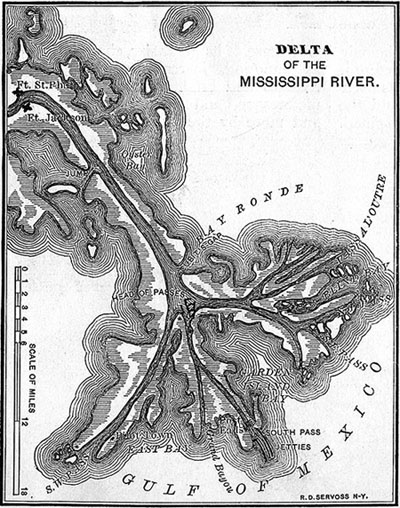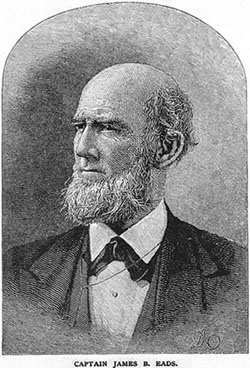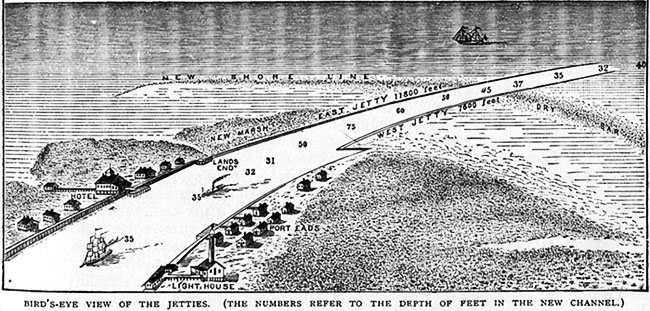Rewriting Geography
Today, geography shifts before our eyes. The University of Houston's College of Engineering presents this series about the machines that make our civilization run, and the people whose ingenuity created them.
 The Mighty Mississippi is a force of nature. I've stepped across it in northern Minnesota. Every hour that same river carries two billion cubic feet of water into the Gulf of Mexico. It gathers its flow from a watershed of over a million square miles.
The Mighty Mississippi is a force of nature. I've stepped across it in northern Minnesota. Every hour that same river carries two billion cubic feet of water into the Gulf of Mexico. It gathers its flow from a watershed of over a million square miles.
Eighty miles southeast of New Orleans, it splays into three channels. The Mississippi Delta is less like the Greek letter delta, and more like a three-toed bird's foot. Every 800 years, the Mississippi changes its course and builds up a new delta while the Gulf of Mexico erodes the last one away. For thousands of years, it's built up one such delta after another.
But today's delta is an exception. Constrained by levees, the river should've lurched into the Atchafalaya Basin over a century ago. How long it can be held is a question for another day. Right now, let's look at the delta. The Mississippi once deposited huge amounts of silt. Until 1950, the talons on the bird's foot reached ever further into the Gulf. Then levee-building caught up with it.
The river now deposits much less silt and less groundwater. The delta is subsiding and shrinking. It's still much larger than it was in the mid-19th century but it's retreating. And Hurricane Katrina gave us good reason for even greater levee development.
We see a lot of that along the Gulf coast. Bayous in the coastal plains meander freely about the flat land. But in cities, we bind our waterways into straight manmade concrete channels. We assert control over them.
 All this became dramatically clear when I found an 1879 article in Scribner's Monthly. It's about James Eads' work on containing the river. During the Civil War Eads designed the Yankee gunboat Cairo. After the War, he built the famous St. Louis Bridge across the Mississippi. Then he built levees in the Delta.
All this became dramatically clear when I found an 1879 article in Scribner's Monthly. It's about James Eads' work on containing the river. During the Civil War Eads designed the Yankee gunboat Cairo. After the War, he built the famous St. Louis Bridge across the Mississippi. Then he built levees in the Delta.
The article begins with a typical scene just before the Civil War. Fifty-five vessels are lined up in the lower Mississippi. Each one must be slowly towed across the silt that's built up. Almost eight thousand tons of freight is stymied for weeks.
Eads contrived to build what the article calls jetties on either side of the exit channels. These were actually levee walls that narrowed the channel so it could be dredged to a good depth. They also sped the flow so silt wouldn't deposit until it reached open water. And it worked: Ship delays were virtually eliminated. Grain shipments increased twenty-fold. A bird's eye drawing of the jetties shows the stern imposition of human will on unruly nature.
Today, the last town on the contained river mouth is very appropriate named Venice. If the Mississippi above Venice ever does move into the Atchafalaya Basin, river towns like Baton Rouge and New Orleans will be left high and dry. But Venice is too far out; it will die a very different death. It will gradually erode away while a new delta builds up in a geography that doesn't yet exist.
I'm John Lienhard at the University of Houston, where we're interested in the way inventive minds work.
The Mississippi Jetties. (no named author) Scribner's Monthly, Vol. XIX, Nov. 1879, No. 1, pp. 46-57. All images from this source.
See also the Wikipedia article about the Delta.
For more on this topic see Episode 1135. My thanks to colleague Lewis Wheeler for his counsel.
